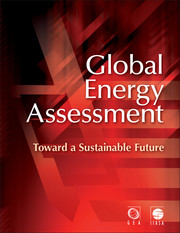Book contents
- Frontmatter
- Contents
- Section 1
- Section 2
- Section 3
- Cluster 1
- Cluster 2
- Cluster 3
- Chapter 17 Energy Pathways for Sustainable Development
- Chapter 18 Urban Energy Systems
- Chapter 19 Energy Access for Development
- Chapter 20 Land and Water: Linkages to Bioenergy
- Chapter 21 Lifestyles, Well-Being and Energy
- Cluster 4
- Section 4
- Index
- References
Chapter 18 - Urban Energy Systems
Published online by Cambridge University Press: 05 September 2012
- Frontmatter
- Contents
- Section 1
- Section 2
- Section 3
- Cluster 1
- Cluster 2
- Cluster 3
- Chapter 17 Energy Pathways for Sustainable Development
- Chapter 18 Urban Energy Systems
- Chapter 19 Energy Access for Development
- Chapter 20 Land and Water: Linkages to Bioenergy
- Chapter 21 Lifestyles, Well-Being and Energy
- Cluster 4
- Section 4
- Index
- References
Summary
Executive Summary
More than 50% of the global population already lives in urban settlements and urban areas are projected to absorb almost all the global population growth to 2050, amounting to some additional three billion people. Over the next decades the increase in rural population in many developing countries will be overshadowed by population flows to cities. Rural populations globally are expected to peak at a level of 3.5 billion people by around 2020 and decline thereafter, albeit with heterogeneous regional trends. This adds urgency in addressing rural energy access, but our common future will be predominantly urban. Most of urban growth will continue to occur in small-to medium-sized urban centers. Growth in these smaller cities poses serious policy challenges, especially in the developing world. In small cities, data and information to guide policy are largely absent, local resources to tackle development challenges are limited, and governance and institutional capacities are weak, requiring serious efforts in capacity building, novel applications of remote sensing, information, and decision support techniques, and new institutional partnerships. While ‘megacities’ with more than 10 million inhabitants have distinctive challenges, their contribution to global urban growth will remain comparatively small.
Energy-wise, the world is already predominantly urban. This assessment estimates that between 60–80% of final energy use globally is urban, with a central estimate of 75%. Applying national energy (or GHG inventory) reporting formats to the urban scale and to urban administrative boundaries is often referred to as a ‘production’ accounting approach and underlies the above GEA estimate.
- Type
- Chapter
- Information
- Global Energy AssessmentToward a Sustainable Future, pp. 1307 - 1400Publisher: Cambridge University PressPrint publication year: 2012
References
- 70
- Cited by

